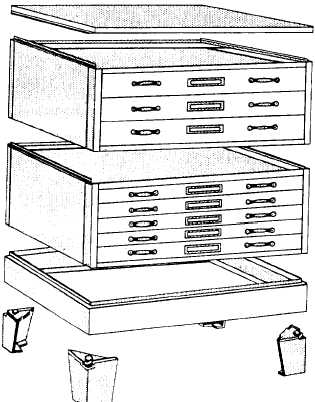must coordinate their work efforts and cooperate
with one another as one big team. Most surveying
operations are performed to guide the work done
by other construction crews. You must therefore
work closely with other crew leaders to ensure that
your surveys are timely and do not delay
the overall project. Cooperation with other
supervisors will eliminate many problems that
would otherwise arise when you are coordinating
work efforts. In effect, you are merging your ideas
and efforts to make the project run smoothly.
Cooperation is also essential to your success
as a drafting supervisor. Consult the Builder crew
supervisor on design problems and construction
methods. Spending too much time on unnecessary
details could delay the job if the Builders are
awaiting the drawings to start the job. So right
from the start, get into the habit of cooperating
with other supervisors, and you will soon gain
their respect as well as the respect of your
superiors and your crew members.
MAINTAINING FILES
Maintaining file records, or simply “filing,”
is one job an EA needs to learn fast and well.
When you are transferred to a new unit or
command, chances are good that you will be
involved in organizing and keeping track of a
variety of engineering drawings normally found
in the drafting and reproduction section. Your
biggest challenge in filing is to make it possible
for any single drawing (sheet), as well as the record
pertaining to that particular drawing, to be readily
located. Since most filing cabinets or protected
stowage receptacles are limited in space, you may
develop an ingenious approach to a highly
organized filing system.
You must keep in mind that each engineering
drawing is commonly identifiable by a drawing
number assigned by the agency (such as NAV-
FACENGCOM) that made the drawing. The first
major file breakdown for drawings, then, is a
breakdown into separate files for the different
agencies that have supplied the drawings. Within
each agency file, the most convenient way to file
drawings and prints is by the numerical sequence
of drawing numbers.
Filing Original Copies
Original drawings and sepia copies are filed
flat-NEVER folded. For large size originals, use
shallow-drawer file cabinets of the type shown in
figure 16-3. Smaller size drawings are generally
Figure 16-3.-Shallow-drawer cabinet for filing large original
drawings, tracings, and negatives.
stowed on edge in the standard deep-drawer-type
cabinet, as shown in figure 16-4. Each drawer
is divided into compartments by stationary
partitions, and in each compartment there is a
“compressor spring” to keep the drawings on
edge and in a compressed stack.
Filing Prints and Data
Prints are handled in a manner appropriate
for their current status. Prints of drawings for
active projects are generally placed on STICK
FILES for easy reference. Stick files are either
manufactured metal components or locally
prepared strips of wood. Inactive prints, such as
those from completed projects and some as-built
drawings, are either stowed flat in shallow-drawer
file cabinets (fig. 16-3) or folded and stowed in
the standard deep-drawer-type cabinet (fig. 16-4).
Extra sets of project drawings are sometimes
rolled and stowed in some type of cylindrical
plastic or cardboard tube.
16-8

